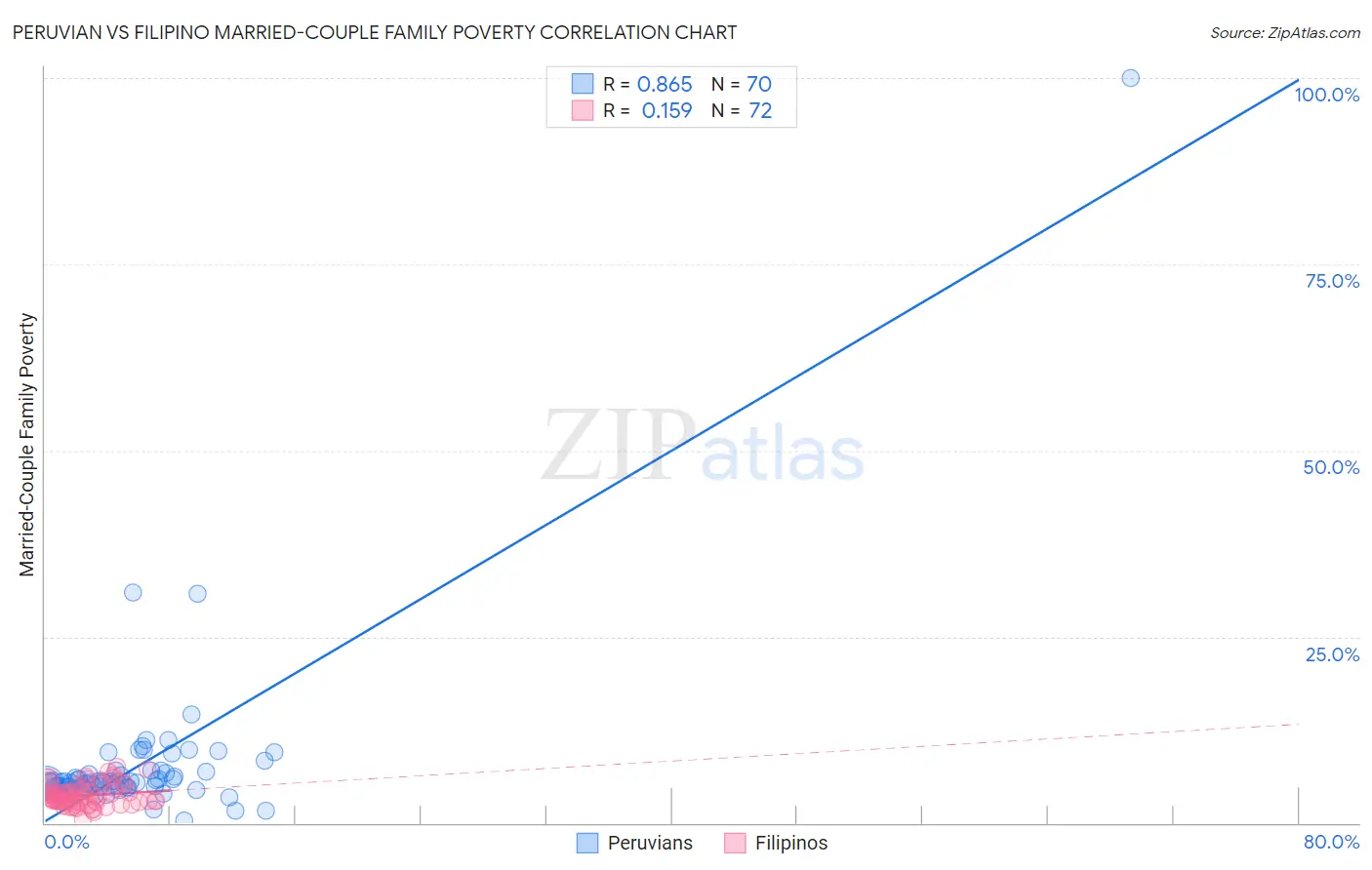Peruvian vs Filipino Married-Couple Family Poverty
COMPARE
Peruvian
Filipino
Married-Couple Family Poverty
Married-Couple Family Poverty Comparison
Peruvians
Filipinos
5.3%
MARRIED-COUPLE FAMILY POVERTY
37.6/ 100
METRIC RATING
183rd/ 347
METRIC RANK
4.0%
MARRIED-COUPLE FAMILY POVERTY
100.0/ 100
METRIC RATING
17th/ 347
METRIC RANK
Peruvian vs Filipino Married-Couple Family Poverty Correlation Chart
The statistical analysis conducted on geographies consisting of 360,614,929 people shows a very strong positive correlation between the proportion of Peruvians and poverty level among married-couple families in the United States with a correlation coefficient (R) of 0.865 and weighted average of 5.3%. Similarly, the statistical analysis conducted on geographies consisting of 252,645,683 people shows a poor positive correlation between the proportion of Filipinos and poverty level among married-couple families in the United States with a correlation coefficient (R) of 0.159 and weighted average of 4.0%, a difference of 31.2%.

Married-Couple Family Poverty Correlation Summary
| Measurement | Peruvian | Filipino |
| Minimum | 0.26% | 0.49% |
| Maximum | 100.0% | 7.5% |
| Range | 99.7% | 7.0% |
| Mean | 8.0% | 3.7% |
| Median | 5.5% | 3.3% |
| Interquartile 25% (IQ1) | 4.9% | 2.8% |
| Interquartile 75% (IQ3) | 7.0% | 4.4% |
| Interquartile Range (IQR) | 2.2% | 1.6% |
| Standard Deviation (Sample) | 12.1% | 1.4% |
| Standard Deviation (Population) | 12.1% | 1.4% |
Similar Demographics by Married-Couple Family Poverty
Demographics Similar to Peruvians by Married-Couple Family Poverty
In terms of married-couple family poverty, the demographic groups most similar to Peruvians are Immigrants from Vietnam (5.3%, a difference of 0.010%), Immigrants from Chile (5.3%, a difference of 0.14%), Immigrants from Sierra Leone (5.3%, a difference of 0.20%), Nonimmigrants (5.3%, a difference of 0.22%), and American (5.3%, a difference of 0.28%).
| Demographics | Rating | Rank | Married-Couple Family Poverty |
| Menominee | 47.8 /100 | #176 | Average 5.2% |
| Immigrants | Kazakhstan | 45.1 /100 | #177 | Average 5.2% |
| Immigrants | Ukraine | 44.9 /100 | #178 | Average 5.2% |
| Spanish | 41.4 /100 | #179 | Average 5.3% |
| Immigrants | Sierra Leone | 39.3 /100 | #180 | Fair 5.3% |
| Immigrants | Chile | 38.8 /100 | #181 | Fair 5.3% |
| Immigrants | Vietnam | 37.7 /100 | #182 | Fair 5.3% |
| Peruvians | 37.6 /100 | #183 | Fair 5.3% |
| Immigrants | Nonimmigrants | 35.8 /100 | #184 | Fair 5.3% |
| Americans | 35.4 /100 | #185 | Fair 5.3% |
| Hungarians | 34.7 /100 | #186 | Fair 5.3% |
| Immigrants | Albania | 33.8 /100 | #187 | Fair 5.3% |
| Israelis | 33.1 /100 | #188 | Fair 5.3% |
| South American Indians | 32.5 /100 | #189 | Fair 5.3% |
| Ugandans | 31.6 /100 | #190 | Fair 5.3% |
Demographics Similar to Filipinos by Married-Couple Family Poverty
In terms of married-couple family poverty, the demographic groups most similar to Filipinos are Italian (4.0%, a difference of 0.010%), German (4.0%, a difference of 0.030%), Polish (4.0%, a difference of 0.30%), Slovak (4.0%, a difference of 0.33%), and Czech (4.0%, a difference of 0.37%).
| Demographics | Rating | Rank | Married-Couple Family Poverty |
| Carpatho Rusyns | 100.0 /100 | #10 | Exceptional 3.9% |
| Lithuanians | 100.0 /100 | #11 | Exceptional 4.0% |
| Bulgarians | 100.0 /100 | #12 | Exceptional 4.0% |
| Czechs | 100.0 /100 | #13 | Exceptional 4.0% |
| Slovaks | 100.0 /100 | #14 | Exceptional 4.0% |
| Poles | 100.0 /100 | #15 | Exceptional 4.0% |
| Germans | 100.0 /100 | #16 | Exceptional 4.0% |
| Filipinos | 100.0 /100 | #17 | Exceptional 4.0% |
| Italians | 100.0 /100 | #18 | Exceptional 4.0% |
| Immigrants | Ireland | 99.9 /100 | #19 | Exceptional 4.1% |
| Maltese | 99.9 /100 | #20 | Exceptional 4.1% |
| Zimbabweans | 99.9 /100 | #21 | Exceptional 4.1% |
| Immigrants | Singapore | 99.9 /100 | #22 | Exceptional 4.1% |
| Bhutanese | 99.9 /100 | #23 | Exceptional 4.1% |
| Eastern Europeans | 99.9 /100 | #24 | Exceptional 4.1% |